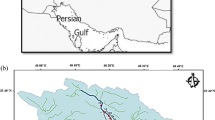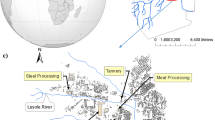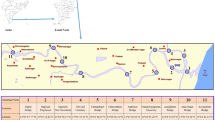Abstract
Contamination of nutrients and heavy metals within aquatic system is of great concern due to its potential impact on human and animal health. The Grand Canal of China, the largest artificial river in the world, is of great importance in supplying water resource, transporting cargo, and recreating resident, as well as great historical heritage. This study assessed and examined the impact of human activities on characters of contamination distribution within the section of the Canal in Taihu watershed. Physicochemical parameters of surface water quality were determined monthly from the year 2004 to 2006 at 11 sites that were influenced by different anthropogenic activities along the Canal. Moreover, contaminations at surface sediments (20 cm) at the same locations were also analyzed in September 2006. Results showed that the Canal had been seriously polluted, which was characterized with high spatial variations in contaminations distribution. The sites influenced mainly by industry and urbanization showed higher contents of nutrients and lower levels of dissolve oxygen than other sites. Concentrations of nitrogen at all studied sites exceeded the worst level of surface water quality according to the National Criterion of Surface Water Quality, China, with the average values varying from 2.27 to 10.34 mg/L. Furthermore, the site influenced mainly by industry (i.e., Site 4) presented the highest contents of cadmium (3.453 mg/kg), chromium (196.87 mg/kg), nickel (87.12 mg/kg), zinc (381.8 mg/kg), and copper (357.32 mg/kg). While sites in vicinity to cities had presented relatively higher contents of metals, especially for the site located downstream of Changzhou City (Site 3) had presented the highest contents of mercury (1.64 mg/kg) and lead (197.62 mg/kg). Copper at Sites 2 to 6, Nickel at Sites 2 to 9 except for Site 7, chromium, lead, and zinc at Sites 3 to 6 had exceeded New York State Department of Environmental Conservation (NYSDEC) Severe Effect Level (SEL). By multivariate statistical, nutrient variables, companied with V-phen, had contributed the most variation of water quality, while nutrient and metals had explained the most part of total variance of contaminations in sediment. This study indicated that the canal had been polluted severely and urgently need to control.
Similar content being viewed by others
References
American Public Health Association (1998). Metals by flame atomic absorption spectrometry. In L. S. Clesceri, A. E. Greenberg, & A. D. Eaton (Eds.), Standard methods for the examination of water and wastewater (20th ed., pp. 3–1303–22). Washington, DC: American Public Health Association.
Bernard, P., Antoine, L., & Bernard, L. (2004). Principal component analysis: An appropriate tool for water quality evaluation and management—application to a tropical lake system. Ecological Modelling, 178, 295–311.
Cai, Q. M., Gao, X. Y., Chen, Y. W., Ma, S. W., & Dokulil, M. (1997). Dynamic variations of water quality in Taihu Lake and multivariate analysis of its influential factors. Journal of Chinese Geography, 7, 72–82.
Cao, C., Zhu, J. G., Zhu, J. Y., Cao, X., Dou, Y. J., & Hosen, Y. (2004). Nitrogen export from an agriculture watershed in the Taihu Lake area. Environmental Geochemistry and Health, China, 26, 199–207.
Cao, X. H., & Zhou, E. (2006). Influence of water diversion of Wangyu River on water environment of west Changshu City. Water Resource Protection, China, 22, 48–50.
Chen, L., & Zhao, J. F. (2004). Environmental monitor. Beijing: Chemical Industry Press.
Chen, Y. X., Liu, H., Zhu, G. W., & Chen, H. (2004). Pollution characteristics of the recent sediments in the Hangzhou section of the Grand Canal, China. Journal of Environmental Sciences, 16, 34–39.
Dalmacija, B., Prica, M., Ivancev-Tumbas, I., Van der Kooij, Roncevic, S., Krcmar, T., et al. (2006). Pollution of the Begej Canal sediment-metals, radioactivity and toxicity assessment. Environmental International, 32, 606–615.
Donohue, I., Martin, L., Garrigle, M., Paul, M. (2006). Linking catchment characteristics and water chemistry with the ecological status of Irish rivers. Water Research, 40, 91–98.
Dylan, S., Richard, W., Sheibley, R. A., Dahlgren, M. A., Joshua, J., & Kenneth, W. T. (2005). Land use and land cover influence on water quality in the last free-flowing river draining the western Sierra Nevada, California. Journal of Hydrology, 313, 234–247.
Evans, C. D., Monteith, D. T., & Cooper, D. M. (2005). Long-term increases in surface water dissolved organic carbon: Observations, possible causes and environmental impacts. Environmental Pollution, 137, 55–71.
Geoffrey, J. P., Ranjeet, K. T., Hua, Z., David, Y., Brent, M. P., & Luying, X. (2008). Mobility and recalcitrance of organo–chromium (III) complexes. Chemosphere, 70, 2054–2059.
Gibert, C. S., & Wendy, A. T. (2003). Watershed scale assessment of nitrogen and phosphorus loadings in the Indian River Lagoon basin, Florida. Environmental Management, 67, 363–372.
Graney, J. R. & Eriksen, T. M. (2004). Metals in pond sediments as archives of anthropogenic activities: A study in response to health concerns. Applied Geochemistry, 19, 1177–1188.
Harris, G. P., & Heathwaite, A. L. (2005). Inadmissible evidence: Knowledge and prediction in land and riverscapes. Journal of Hydrology, 304, 3–19.
Haygarth, P. M., Wood, F., Heathwaite, A. L., & Butler, P. (2005). Phosphorus dynamics observed through increasing scales in a nested headwater-to-river channel study. Science of the Total Environment, 344, 83–106.
Janel, E., Owens, E. D., & Niemeyer, D. (2006). Analysis of chemical contamination within a canal in a Mexican border colonia. Environmental Pollution, 140, 506–515.
Jarvie, H. P., Haygarth, P. M., Neal, C., Butler, P., & Smith, B. (2008). Stream water chemistry and quality along an upland-lowland rural land-use continuum, south west England. Journal of Hydrology, 350, 215–231.
Jin, X. C. (1998). Criterion of eutrophiction survey on lakes. Beijing: Environmental Science Press.
Kepner, G. W., Semmens, J. D., Bassett, D. S., Mouat, A. D., & Goodrich, C. D. (2004). Scenario analysis for the San Pedro River, analysing hydrological consequences of a future environment. Environment Monitor and Assessment, 94, 115–127.
Kirchner, J. W., Feng, X., & Neal, C. (2000). Fractal stream chemistry and its implications for contaminant transport in catchments. Nature, 403, 524–527.
Kunwar, P. S., Amrita, M., & Sarita, S. (2005). Water quality assessment and apportionment of pollution sources of Gomti River (India) using multivariate statistical techniques-a case study. Analytical Chimical Acta, 538, 355–374.
Lau, S. S. S., & Lane, S. N. (2002). Biological and chemical factors influencing shallow lake eutrophication: A long-term study. Science of the Total Environment, 228, 167–181.
Lawlor, A. J., & Tipping, E. (2003). Metals in bulk deposition and surface waters at two upland locations in Northern England. Environmental Pollution, 121, 153–168.
Liu, L. (2005). Research of measure methods of petroleum-like matters in industrial waste water. Metallurgical Power, China, 111, 60–63.
Liu, W., Wang, Z., Wen, X., & Tang, H. (1999). The application of preliminary sediment quality criteria to metal contamination in the Le An River. Environmental Pollution, 105, 355–366.
Ludwig, J. A., & Reynolds, J. F. (1988). Statistical ecology. New York: Wiley.
Luo, J., Pang, Y., & Yang, S. (2005). Study on flux of pollutants discharged into Taihu Lake through main inflow river channels. Journal of Hohai University, 33, 131–135.
Maria, J. B., & Graca, C. (2006). Identification of similar environmental areas in Tagus estuary by using multivariate analysis. Ecological Indictor, 6, 508–515.
Massoud, M., El-Fadel, M., Scrimshaw, M. D., & Lester, J. N. (2006). Factors influencing development of management strategies for the Abou Ali River in North Lebanon I: Spatial variation and land use. Science of the Total Environment, 362, 15–30.
Mdegela, R. H., Braathen, M., Rereka, A. E. P., Mosha, D., Sandvik, M., & Skaare, J. U. (2009). Heavy metals and organochlorine residues in water, sediments, and fish in aquatic ecosystems in Urban and Peri-Urban areas in Tanzania. Water, Air, and Soil Pollution, 203(1–4), 369–379.
Neal, C., House, W. A., Jarvie, H. P., Neal, M., Hill, L., & Wickham, H. (2005). Phosphorus concentrations in the River Dun, the Kennet and Avon Canal and the River Kennet, southern England. Science of the Total Environment, 344, 107–128.
Neal, C., House, W. A., Helen, P., Margaret, N., Linda, H., & Heather, W. (2006). The water quality of the River Dun and the Kennet and Avon Canal. Journal of Hydrology, 330, 155–170.
NYSDEC (New York State Department of Environmental Conservation) (1999). Technical guidance for screening contaminated sediments. Albany: Division of Fish, Wildlife and Marine Resource.
Pan, S. B., Cao, L. P., & Zhang, J. L. (2005). Water quality management in China: Situation, problems and challenges. Water Resource Protection, China, 21, 59–62.
Pu, P. M., Hu, W. P., Yan, J. S., Wang, G. X., & Hu, C. G. (1998). A physico-ecological engineering experiment for water treatment in a hypertrophic lake in China. Ecollgical Engineering, 10, 179–190.
Qu, W. C., Mike, D., & Wang, S. M. (2001). Multivariate analysis of heavy metal and nutrient concentrations in sediments of Taihu Lake, China. Hydrobiologia, 450, 83–89.
Reyment, R., Joreskog, K. G. (1993). Applied factor analysis in the natural sciences. Cambridge: Cambridge University Press.
Simeonova, V., Stratisb, J. A., Samarac, C., Zachariadisb, G., Voutsac, D., & Anthemidis, A. (2003). Assessment of the surface water quality in Northern Greece. Water Research, 37, 4119–4124.
Wang, X. L., Lu, Y. L., Han, J. Y., He, G. Z., & Wang, T. Y. (2004). Identification of anthropogenic influences on water quality of rivers in Taihu watershed. Journal of Environmental Science, 9, 475–481.
Wang, X. L., Lu, Y. L., He, G. Z., Wang, T. Y., & Han, J. Y. (2007). Multivariate analysis of interactions between phytoplankton biomass and environmental variables in Taihu Lake, China. Environmental Monitor and Assessment, 133, 243–253.
Zeng, A. B.,Wang, C. H., & Ruan, J. N. (2005). The water quality analysis for Beijin-Hangzhou Grand Canal (Hangzhou Section) and countermeasures for pollution. Journal of Shenyang Agricultural University, 36, 631–633.
Zhang, L., Fan, C. X., Chi, Q. Q., Wang, J. J., & Qin, B. Q. (2004). Phosphorus species distribution of sediments in Lake Taihu and its main inflow rivers. Geochemistry, China, 33, 423–432.
Zheng, Y., Wang, X. J., & Liu, X. B. (2001). Analysis on water quality of rivers around Tai Lake and estimation of total pollutant load into Tai Lake. China Lake Science, 17, 40–44.
Zoumins, T., Schmidt, A., Grigorova, L., & Calmano, W. (2001). Contaminant in sediments: Remobilization and demobilization. Science of the Total Environment, 266, 195–202.
Author information
Authors and Affiliations
Corresponding author
Rights and permissions
About this article
Cite this article
Wang, X., Han, J., Xu, L. et al. Effects of anthropogenic activities on chemical contamination within the Grand Canal, China. Environ Monit Assess 177, 127–139 (2011). https://doi.org/10.1007/s10661-010-1623-0
Received:
Accepted:
Published:
Issue Date:
DOI: https://doi.org/10.1007/s10661-010-1623-0




